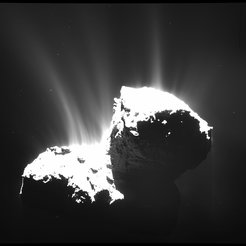The fine structure of activity jets of 67P/C-G
OSIRIS images of Rosetta's comet show unprecedented details of dust jets
Comet 67P/Churyumov-Gerasimenko has shown activity in the form of dust jets for a few months now. Recent OSIRIS images reveal that large scale jets as seen in previous images can now be resolved into many smaller jets emerging from the surface and then unite further away from the comet nucleus. The ‘neck’ region is still showing a very strong activity but jets are also emerging from the comet’s ‘head’ and ‘body’ with the increased activity of the comet.

“This is still the beginning of the activity compared to what we expect to see in summer this year”, says OSIRIS Principle Investigator Holger Sierks from the Max Planck Institute for Solar System Research (MPS) in Germany. “From the last perihelion passage we know that the comet will evolve by a factor of 100 in activity at that time compared to now.” But already on November 22nd, when this image was taken, the jets were strong enough to show distinct features, from which the OSIRIS scientists aim to understand the physical processes that are creating and shaping them.
This image is from a set of observations dedicated to the investigation of general activity. The Rosetta spacecraft was orbiting 67P at a distance of 30km, and looking at the Southern hemisphere of the nucleus. This image taken by the OSIRIS wide angle camera covers both, nucleus and coma, in a single frame. The nucleus is overexposed, in order to reveal the faint jets in the coma: collimated streams of gas and dust arising from the surface.
The jets were observed over one full rotation. “By tracking them from image to image, we reconstruct their 3 dimensional structures and link them to specific areas on the nucleus, of which the morphology and composition is now being investigated”, explains OSIRIS scientist Jean-Baptiste Vincent from MPS. By understanding where exactly the jets are emerging, e.g., from the cliffs or planes, the scientists will reveal the physical reasons of activity. From the appearance of individual jets (for instance how small jets are merged into larger ones, or how they are bending), the scientists can learn about how the jets interact with the larger dust particles and gas coma, that is surrounding the comet.
In addition to the jets, this image also reveals many surface features from the dark side of the comet. Although this region is not yet illuminated directly, the diffuse light reflected from other areas allows distinguishing the morphology thanks to the high dynamic range of the OSIRIS CCD. Finally, one can see in the bottom right of the image an almost vertical line separating two regions of the coma with slightly different brightness. “This is actually the shadow of the nucleus, cast onto the coma”, clarifies Jean-Baptiste Vincent.
Rosetta is an ESA mission with contributions from its member states and NASA. Rosetta's Philae lander is provided by a consortium led by DLR, MPS, CNES and ASI. Rosetta is the first mission in history to rendezvous with a comet, escort it as it orbits the Sun, and deploy a lander to its surface.
The scientific imaging system OSIRIS was built by a consortium led by the Max Planck Institute for Solar System Research (Germany) in collaboration with CISAS, University of Padova (Italy), the Laboratoire d'Astrophysique de Marseille (France), the Instituto de Astrofísica de Andalucia, CSIC (Spain), the Scientific Support Office of the European Space Agency (The Netherlands), the Instituto Nacional de Técnica Aeroespacial (Spain), the Universidad Politéchnica de Madrid (Spain), the Department of Physics and Astronomy of Uppsala University (Sweden), and the Institute of Computer and Network Engineering of the TU Braunschweig (Germany). OSIRIS was financially supported by the national funding agencies of Germany (DLR), France (CNES), Italy (ASI), Spain (MEC), and Sweden (SNSB) and the ESA Technical Directorate.
